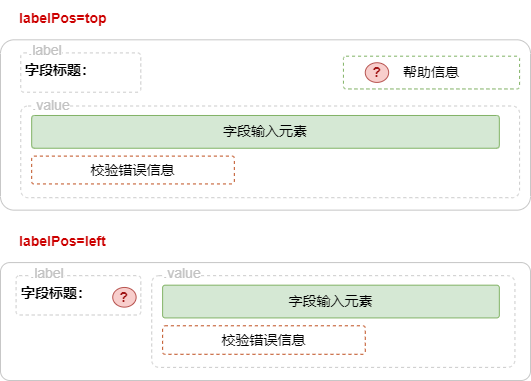字段
关于
AutoForm的所有字段组件均是以auto-field-开头的WebComponent,用于渲染表单字段。
字段组件的DOM结构如下:

字段的DOM结构由以下几部份组成:
| 名称 | 描述 |
|---|---|
| 字段标题 | 支持显示在左侧或顶部 |
| 字段输入元素 | 支持各种输入字段元素 |
| 帮助信息 | 额外的帮助信息 |
| 错误信息 | 当校验出错时显示信息 |
指南
声明字段
在AutoStore状态使用configurable方法声明字段,
const store = new AutoStore({
user: {
username: configurable('NAME', {
label: '用户名',
widget: 'input'
})
},
});使用configurable声明状态中的某个状态值可配置时,可通过widget参数指定要渲染的字段组件类型。
支持的字段组件:
captcha,checkbox-group,checkbox,color-picker,combine,custom,date,email,input,ipaddress,list,number,parts,password,phone,qrcode,radio-button,radio,range,rating,search,select,switch,textarea,time,tree-dropdown,tree-select,upload,url,verifycode
字段帮助
字段可以通过help参数指定额外的帮助信息。
const store = new AutoStore({
user: {
username: configurable('NAME', {
label: '用户名',
help: '请输入用户名'
}),
password:configurable('', {
label: '密码',
widget: 'password',
// 启用超链接
help: '密码至少6位(https://zhangfisher.github.io/voerka-i18n/)'
})
},
});帮助信息可以在未尾(<url>)启用超链接
通用字段属性
使用configurable函数声明一个状态的值可配置,即字段,可以传入多个字段属性。
const store = new AutoStore({
user: {
username: configurable('<默认值>', {
// ... 字段参数或属性
}
})字段支持以下通用属性:
export type SchemaWidgetShareOptions<Value, State> = {
name?: string;
required?: boolean;
visible?: boolean;
enable?: boolean;
description?: string;
size?: string | number;
icon?: string;
// 用于验证
invalidTips?: string | ((e: Error, path: string, newValue: Value, oldValue: Value) => string);
onValidate?: (newValue: Value, oldValue: Value, path: string) => boolean;
onFail?: 'pass' | 'throw' | 'ignore' | 'throw-pass';
// 提供一些元数据
label?: string;
labelPos?: string;
// 帮助信息可以增加一个链接,如"至少需要增加(http://www.baidu.com)"
help?: string;
placeholder?: string;
group?: string;
advanced?: boolean;
order?: number;
width?: number | string;
height?: number | string;
divider?: boolean; // 是否在前面显示一条分割线
viewAlign?: 'left' | 'center' | 'right'; // viewonly模式下显示方式
tips?: string;
select?: (SchemaWidgetSelectItem<Value> | string | number)[];
// 转换数据
toView?: (value: any) => any;
toState?: (value: any) => any;
toInput?: (value: any) => any;
toRender?: (value: any) => any;
actions?: SchemaWidgetAction<State>[];
// 用于扩展widget样式,如{"<选择器>":"样式"}
styles?: SchemaWidgetStyles;
// 用于扩展widget类,如{"<选择器>":"类名"}
classs?: SchemaWidgetClasss;
};字段宽度/高度
可以通过width和height参数指定字段宽度和高度。
提示
当在一行中显示多个字段时,需要指定height参数以确保字段高度一致。
自定义浏览视图
toView方法用于自定义浏览视图。
const store = new AutoStore({
user: {
age: configurable(18, {
label: '年龄',
toView: (value) => {
return `<span
style="color:red;border:1px solid red;padding:4px;">
${value}岁</span>`
}
})
}
});必填字段
required参数用于指定字段是否必填。必填字段显示红色*号。
const store = new AutoStore({
user: {
name: configurable('', {
label: '姓名',
required:true
})
password: configurable('', {
label: '密码',
required:true
})
}
});状态数据转换
toInput和toState方法用于状态数据和输入之间的转换。
toInput: 用于将AutoStore中的状态数据转换为输入数据用于渲染和编辑toState: 用于将输入元素的数据转换为AutoStore中的状态数据
例如: 在下例状态中,sex 字段为1或0,在输入时,需要渲染为男或女,则可以如下配置:
const store = new AutoStore({
user: {
sex: configurable(0, {
label: '性别',
toInput: (value) => {
return value === 1 ? '男' : '女'
},
toState: (value) => {
return value === '男' ? 1 : 0
}
})
},
});样式控制
如果对字段的样式不满意,可以通过styles和classs参数进行样式控制。
- styles
类型:type SchemaWidgetStyles = Record<string, string | Record<string, string>>
用于扩展字段DOM结构下的自定义样式,支持:
styles = {
// <选择器>: <样式>
'.label': 'color:red;border:1px solid red',
};
// 或
styles = {
'.label': {
color: 'red',
border: '1px solid red',
},
};提示
使用 CSS 选择器时,root特指AutoField组件的shadow节点。
- classs
用于扩展字段的样式,如{"<选择器>":"样式"}
const store = new AutoStore({
product: {
name: configurable("voerkai18n", {
label: '产品名称',
styles:{
'.label':'color:red;border:1px solid red'
}
}),
homepage:configurable("https://zhangfisher.github.io/voerka-i18n/", {
label: '官网',
widget: 'url',
styles:{
'sl-input': {
border:'1px solid red'
}
}
})
},
});提示
- 可以通过调试控制台查看字段的
DOM结构,从而进行样式控制。 styles和classs的局限性在于无法选择控制字段组件内部的WebComponent元素,所有的样式控制都只能针对字段组件本身。
字段联动
字段联动指的是字段之间相互影响。
例如:在 IP地址配置表单中,当启用 DHCP 时,IP 地址和子网掩码字段被禁用或隐藏,当禁用 DHCP 时,IP 地址和子网掩码字段必须填写。
字段联动的核心原理是基于AutoStore,当创建AutoStore实例时会扫描收集所有被configurable修饰的状态字段,并使用AutoStore.shadow()方法创建一个Shadow AutoStore对象,用于存储所有可配置数据。
例如:
const store = new AutoStore({
user:{
username:configurable('',{...}),
password:configurable('',{...}),
age:configurable(18,{...}),
sex:configurable(1,{...}),
vip:configurable(false,{...}),
}
})上述代码在创建AutoStore实例时,会同时收集状态树中所有被configurable修饰的状态字段,然后在内部创建一个Shadow AutoStore,
内部伪代码如下:
const shadowStore = new AutoStore({
user_$_username:{...},
user_$_password:{...},
user_$_age:{...},
user_$_sex:{...},
user_$_vip:{...}
})
// 可以通过
store.schmeas.store===shadowStore重点:
- 所有配置字段都会被收集起来创建
AutoStore对象实例,这意味着配置参数可以是计算属性,如
configurable('192.168.1.100', {
label: 'IP地址,
widget: 'ipaddress',
enable: (state)=>!state.network.dhcp
}),- 创建
Shadow AutoStore对象实例和原AutoStore存在关联关系, 当原AutoStore中的状态字段发生变化时,Shadow AutoStore中的计算属性也会重新计算,并且触发字段组件的重新渲染。
在下例中,ip字段和mask字段的显示和隐藏,gateway字段的启用和禁用,都是通过Shadow AutoStore对象实例中的计算属性来控制的。
const store = new AutoStore({
network: {
dhcp: configurable(false, {
label: '自动获取IP地址'
widget: 'switch'
}),
ip: configurable('192.168.1.100', {
label: 'IP地址,
widget: 'ipaddress',
enable: (state)=>!state.network.dhcp
}),
mask: configurable('255.255.255.0', {
label: '子网掩码',
widget: 'ipaddress',
visible: (state)=>!state.network.dhcp
}),
gateway: configurable('192.168.1.1', {
label: '默认网关',
widget: 'ipaddress',
enable: (state)=>!state.network.dhcp
}),
},
});enable: (state)=>!state.network.dhcp的作用就是创建一个计算属性,依赖于state.network.dhcp,当state.network.dhcp的值发生变化时,该计算属性会重新计算,从而触发字段组件的重新渲染。
提示
configurable函数的所有参数均可以是计算属性,并且计算属性的scope始终指向的状态根。
响应式属性
默认情况下,所有字段属性均为响应式属性。